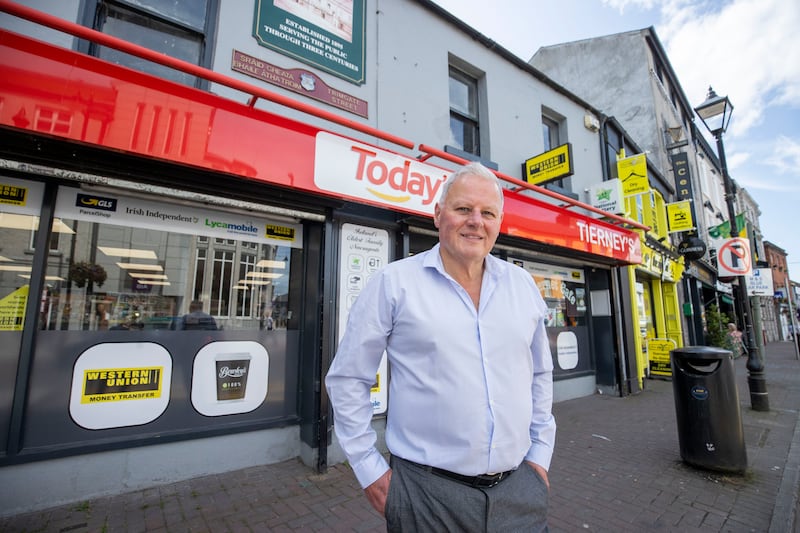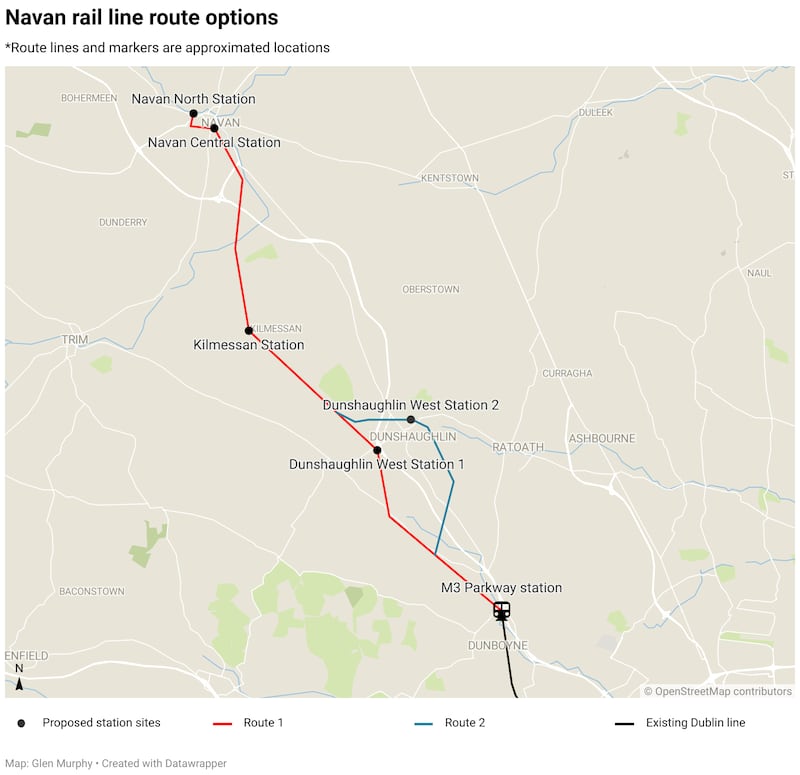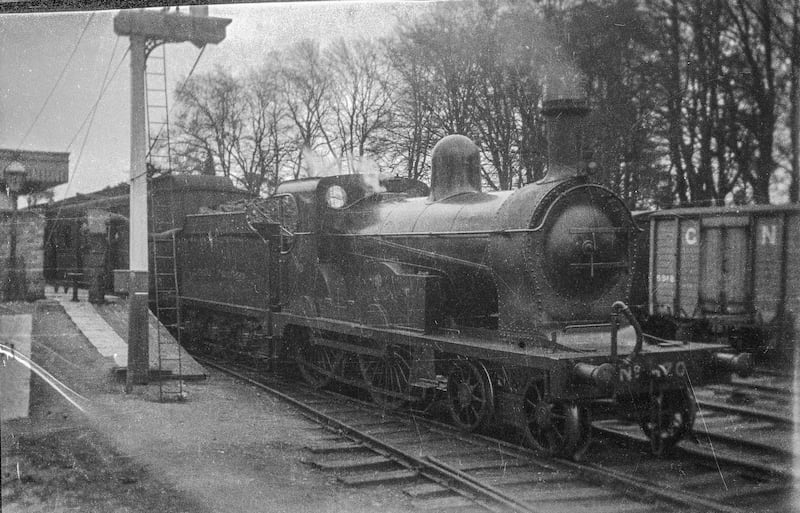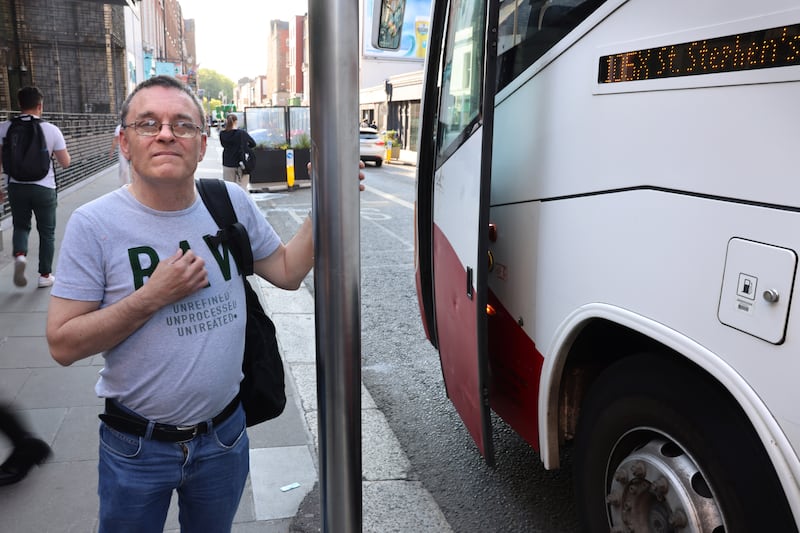Meath is one of the biggest dormitory counties in the country, and the population of its biggest urban centre, Navan, has almost doubled in the last 20 years. Yet the town’s proposed railway line to Dublin will not be open for at least another 13 years.
Transport Infrastructure Ireland (TII) says the rebuilding of the Navan rail line would help with reducing congestion on the M50 and N3. So why is the rail service for this major commuter town not being developed quicker?
A 2019 Meath County Council survey on commuting habits found that, before Covid, 59 per cent of commuters travelled outside the county to work, with 80 per cent of those travelling by car. Findings from the 2022 Census on commuting will not be released until November.
In the 2002 Census, the town’s population was 19,417. Last year, this figure was 33,836. Despite its consistent growth and the town’s proximity to the capital, it remains one of the largest urban areas in the State without a public rail service. The last passenger train left the town in 1958.
READ MORE
The rebuilding of the line is provided for under the Greater Dublin Area transport strategy, with construction due to begin in 2031 and the first services not likely to turn a wheel before 2036.
“We’re among the fastest-growing towns in Ireland and being on the east coast, so close to Dublin, is a huge factor... it’s an attractive place to live,” says local Fianna Fáil councillor Padraig Fitzsimons.
“The coming of the rail line is going to be hugely advantageous.”
This general sentiment on the rail link is echoed across the area’s political spectrum.
“The train would make a massive difference,” says Sinn Féin TD Johnny Guirke. “It’s a no-brainer... We need to start the process today.”
Aontú TD Peadar Tóibín is chair of the Meath on Track campaign group, and says there is “massive demand in the county for [the rail line]”.
Some 4,000 submissions were made during the public consultation process; however, Tóibín argues the timescale of the project “is not acceptable” and that it is “way too far away for people”.
Locally, the prospect of the line opening is a welcome one but has been met with cynicism at times. Talk of rebuilding the line is often “rolled out whenever there’s an election”, says one of the town’s business owners.
Joe Tierney, of Tierney’s newsagents, a third-generation family business on Trimgate Street, says: “It’s been so much pie in the sky for so long... It’s generally not being spoken about because nobody is convinced it’s going to happen. It’s not something that’s been discussed across the counter in my shop for a long time.”
While the more pressing topic for local people seems to be the number of roadworks taking up space on the town’s roads, Tierney reckons “a train that’s being discussed for 2036, 14 years on, it can only excite somebody who’s about 16 at the moment”.

Dermot O’Gara of the National Transport Authority (NTA) says: “While funding for [the line’s] construction is not currently included in the National Development Plan 2021-2030, it is intended to advance the design and planning stage to have the project ready for construction. A design team will be in place later this year.”
Of course, trains do still reach the town. Freight services from Drogheda serve the now - temporarily - mothballed Tara Mines. Tóibín believes this line could be reopened to passenger trains but Jane Cregan, spokesperson for Irish Rail, said the route is “not cleared for passenger services” and “would require significant investment” to bring it up to modern passenger-carrying standards.
Irish Rail is still operating up to 10 freight services a week between the mines and Drogheda for onward movement to Dublin Port and is consulting with Tara Mines’ management on the future of the service.
On a wider scale, future planning for the town can be partially based off the provision of improved public transport.
“The economic and demographic pointers tell you people want to be here,” says Fitzsimons.
[ Tara Mines and Navan: a near-50-year historyOpens in new window ]
Given the town’s growing population, the traffic situation has worsened and Fitzsimons and Guirke also point out that other services in the town, such as GPs, schools and policing, are under stress as a result of more people moving in.
Gavin Lawlor, vice-president of the Irish Planning Institute, believes that Navan “offers lots of very good services” but in planning terms “infrastructure is everything in order to allow development to occur”.
Further afield, the line would help reduce congestion on the M50, a road corridor described as “the Achilles’ heel of the country” by Seán O’Neill, spokesperson for Transport Infrastructure Ireland (TII).
He says TII sees the rail line as a means of curtailing traffic on the N3 and the M50, especially at peak times.
“The knock-on effect is if you can reduce traffic levels during peak times you improve the flow of the M50 corridor, allowing it to function better... it helps with the long-term functionality of the M50 because we can’t make it any wider and we can’t make it a double-decker.”

Trains from Dublin to Meath currently end their journeys at the M3 Parkway station. The NTA’s Navan Rail Line Assessment report from September 2021 outlined two potential routes the line could take.
Option one sees the track extend from the M3 Parkway, along the original alignment with a new station to the west of Dunshaughlin before continuing north to a new Kilmessan station and on to two new stations at Navan – Navan Central and Navan North.
The second option is similar to the first but would see the line break new ground by crossing the M3 to the east side of Dunshaughlin for a new station before continuing on to Kilmessan.
Both routes would offer a 30-minute service frequency with a capacity of 2,536 passengers per hour at peak times.

Long-closed lines are often lamented in Ireland, but the rose-tinted memories are seldom as practical as some might like to acknowledge.
A 1929 working timetable shows services connected the town to Dublin and Drogheda, operated by the Great Southern and Great Northern railways respectively.
The old service would not be acceptable by modern standards. Some three passenger trains a day ran to Dublin and Drogheda each, not including any unscheduled services such as GAA match day specials. The passenger services were spread out across the day. Few people, if any, commuted to the larger urban areas on a daily basis at the time.
A return trip by train to Dublin could have meant catching a service out of Navan around 8am and not being able to get back for a good 12 hours.
‘At least if the train was there it would have the capacity’
Brian McGovern commutes from Co Meath to Dublin city centre daily, a journey that can sometimes take up to four hours return.
He lives in Navan and works in the city as a contractor with a Government department. His daily commute can often take two hours each way.
“Sometimes I’d get the 7.20am bus from Navan, I’d leave the house at five past seven and I’d be in Merrion Row at something like 9am. Coming home, I get a bus at 5.10pm and could be back in Navan for 6.30pm, depending on traffic.”
McGovern’s job sees him working from different locations in the city centre on different days, adding more time to his commute home in the evenings.

“If I work on Adelaide Road where I finish at 5.15pm and if I get [Bus Éireann’s] NX at 5.40pm from Wilton Terrace I would not be in Navan until at least 7.20pm. You’re talking on average two hours a day each.”
He is certain a train service to Navan could save him at least an hour’s travelling each way.
McGovern (52) makes use of several bus services running into the city, both private and those put on by Bus Éireann, the NX route. He says traffic in and around the city can add extra time on to what is already a long commute. He generally leaves home around 7am, or not long after, to get the buses.
“I don’t drive at all, I’m visually impaired. [The train] would make a hell of a lot of difference. You can get in from Drogheda to Dublin in an hour by train... at least with the train there’s a bit of consistency with times,” he says.
“What can happen with Bus Éireann sometimes is the buses can be cancelled at the last minute.”
“Some buses can turn up full and they’re leaving people behind ... Generally [the service] is okay but there are some reliability issues. If the service is reliable people will use it.”
McGovern believes last-minute cancellations or buses showing up full are also a safety issue, when people may be left standing in the open for extended periods of time, particularly in the city centre or during the winter.
“At least if the train was there it would have the capacity.”











